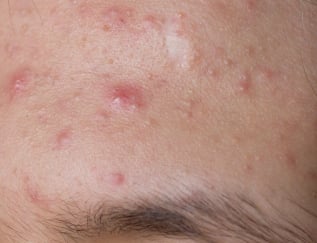
About Face: Treating Teen Acne
19 June 2007
Just about every teen will find at least one blackhead or whitehead on his or her skin by age 17, and some teens will develop more severe acne, which can leave scarring if not treated.
The culprits of acne, experts say, are heredity and hormones. At puberty, the sebaceous or oil glands around the hair follicles on the skin enlarge, and oil production increases. Then, the ducts surrounding the follicles become clogged, and a whitehead or blackhead — called a comedo — results. If a blackhead or whitehead becomes inflamed, a raised, red pimple develops.
Comedones, or ‘zits,’ typically form on the central face area, and can be the first sign of puberty.
Patty Hicks, M.D., a pediatrician on staff at Children’s Medical Center of Dallas
Most cases of pimples, blackheads or whiteheads will clear up quickly, but for some, acne can cause extremely painful, cystlike lesions. Acne can continue for 10 years, but typically vanishes when a person reaches his or her early 20s. For some, however, acne can continue well into adulthood.
Determining which type of acne lesions a teen has is the first step in directing treatment. There are four common types:
Blackheads (or open comedones)
These are caused by pores clogged by debris on the skin surface. Blackheads typically show up on the face, nose and forehead and on the neck, chest and back. (Blackheads have a black center. The black color of a blackhead is not caused by dirt, but by cells and oil in the follicle when they are oxidized by oxygen in the air.) Teens can sometimes open the clogged pores by using a benzoyl peroxide gel applied sparingly four to seven times a week. If this doesn’t help after a couple of months, then your doctor may prescribe a different medication. Teens should also gently clean their skin twice a day. Girls who wear makeup should use face products that won’t encourage blackheads to form. (These products are called noncomedogenic.)
Whiteheads (or closed comedones)
When an plugged follicle remains under the skin, a small white bump or whitehead results. They can sometimes be treated by over the counter benzoyl peroxide cream or with prescription medications.
Papules and pustules
Papules are small bumps on the skin that are inflamed. Pustules (pimples) are papules that are filled with pus. Topical medications such as benzoyl peroxide or tretinoin (prescribed medicine) can often help. An oral antibiotic or prescription cream may be needed.
Cysts or nodules
These are deeper, painful lesions that occur when the infection within the sebaceous gland causes the gland and the area around it to become distorted as the infection spreads below the skin surface. An oral antibiotic or other acne medication like Accutane is often necessary to treat these type of lesions to help prevent scarring
Skin care and treatment
A starting point for good skin care includes thorough but gentle cleansing at least twice daily. Vigorous scrubbing will irritate the skin, making acne worse. Be aware that products that include alcohol or other astringents or harsh detergents can irritate the skin and constrict the pores often making acne worse.
Always protect your skin when outdoors by using an oil-free sunscreen. Occasionally, nodules or deep bumps of acne persist. About 40 percent of teens develop severe enough cases of acne to warrant a doctor’s attention. Then, topical antibiotics may be prescribed. Oral antibiotics, or other acne medicines like Accutane, are sometimes required, but the physician and family should discuss the relative risks and benefits before adding them to the treatment regimen.
Tips to care for acne
- Keep all skin areas prone to acne very clean. Use soap and lots of water; pat areas dry; don’t rub the skin.
- Avoid washing acne prone areas with very hot or very cold water. Lukewarm water is best for not aggravating skin conditions.
- Don’t cover acne with bandages or tight-fitting clothing.
